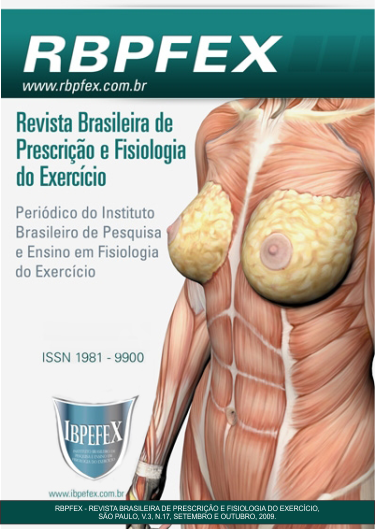Weeks four of resistance training in front pulley improve the performance in the pull-up exercise
Abstract
The Brazilian army makes use of a pull-up exercise to evaluate force of superior members of its personell. The purpose of this study was to determine whether 4 weeks of resistance training in front pulley improves the performance in pull-up exercise. Force is defined as the ability to overcome a neuromuscular external and internal resistance. Study participants were 19 individuals with age of 19.18 years, height of 177.97 cm, body weight of 73.42 kg. All subjects performed the pre-test maximum repetitions in pull-up exercise. The next day, 7 subjects underwent testing in the exercise of 1RM front pulley. Having determined the maximum weight, the individuals underwent 4 weeks of resistance training, 3 times a week, 3 sets of 8 repetitions of 80% 1MR, with 2 minutes apart. The control group only continued running the military physical training (MPT). After 4 weeks, the entire sample group carried out the post-test in the pull-up exercise. The results showed that the average number of repetitions of pull-up exercise in the control group increased from 11.09 ± 2.90 to 12.45 ± 2.01 and not being statistically significant. Moreover, when comparing the individuals trained, we found that the pre-test average (8.28 ± 1.27) was also exceeded by the post-test average (10.57 ± 1.67), and statistically this increase significant. We conclude therefore that the individuals who carried out the resistance training in front pulley had a significant improvement of its performance in the pull-up exercise.
References
- Bean, A. O Guia Completo de Treinamento de Força. 1ª ed. São Paulo. Manole. 1999.
- Bompa, Tudor O. Periodização: Teoria e metodologia do treinamento. 1ª ed. São Paulo. Phorte. 2002.
- Brasil. Estado- Maior do Exército. C 20-20 Manual de Treinamento Físico Militar. Brasília. EGGCF. 2002.
- Dias, R.M.R.; Cyrino, E.S.; Salvador, E.P.; Caldeira, L.F.S.; Nakamura, F.Y.; Papst, R.R.; Brunal, N.; Gurjão, A.L.D. Influência do processo de familiarização para avaliação da força muscular em testes de 1-RM. Revista Brasileira de Medicina do Esporte. São Paulo. Vol. 11. Num. 1. 2005. p. 34-38.
- Fleck, S.J.; Kraemer, W.J. Designning Resistance Training Programs. 2ed. New York. Human Kinetics. 1997.
- Foss, Merle L.; Keteyian, Steven J. Bases Fisiológicas do Exercício e do Esporte. 6ª Ed. Rio de Janeiro. Guanabara Koogan. 2000.
- Guedes, D.P. Treinamento de Força. Centro de Estudos de Fisiologia do Exercício. 2003.
- Kraemer, W.J.; Ratamess, N.A. Fundamentals of Resistance Training: Progression and Exercise Prescription. Medicine & Science in Sports & Exercise. Indianapolis, IN. Vol. 36. Num. 4. 2004. p. 674-688.
- Martins, M.E.A.; dos Santos, F.M.; Arantes, R.P.; Alves, C.S.; Miguel, L.B.; Bastos, J.F.A.; da Silva, S.A.A.; Guilarducci, R.V.; La Porta Jr, M.A.M.; da Silva, E.B. Relação da performance na barra fixa com a força de preensão manual e tempo de sustentação na barra fixa. Revista de Educação Física. Rio de Janeiro. Vol. 128. 2004. p. 65-71.
- Pereira, M.I.R.; Gomes, P.S.C. Testes de força e resistência muscular: confiabilidade e predição de uma repetição máxima – Revisão e novas evidências. Revista Brasileira de Medicina do Esporte. Niterói, RJ. Vol. 09. Num. 05. 2003. p. 325-335.
- Santos, A.; Neto, A.P.; Peres, F.P. Influência do treinamento combinado de força e endurance nas respostas do TAF de militares do 14º GAC. Movimento & Percepção. Espírito Santo de Pinhal, SP. Vol. 05. Num. 06. 2005. p. 163-175.
- Silva, E.B. Efeitos da Freqüência de Treinamento, Ritmo e Pegada na Puxada na Barra Sobre a Força Muscular e Creatina Quinase em Conscritos do Exército Brasileiro. Dissertação apresentada ao Programa de Pós-Graduação em Educação Física da Universidade Gama Filho como requisito à obtenção do título de Mestre em Educação Física, Rio de Janeiro, 1999.
- Uchida, M.C.; Charro, M.A.; Bacurau, R.F.P.; Navarro, F.; Pontes Júnior, F.L. Manual de Musculação: Uma abordagem teórico-prática do treinamento de força. 4ª Ed. São Paulo. Phorte. 2006. p. 29-4.
Authors who publish in this journal agree to the following terms:
- Authors retain the copyright and grant the journal the right of first publication, with work simultaneously licensed under the Creative Commons Attribution License BY-NC which allows the sharing of the work with acknowledgment of the authorship of the work and initial publication in this journal.
- Authors are authorized to enter into additional contracts separately for non-exclusive distribution of the version of the work published in this journal (eg, publishing in institutional repository or book chapter), with acknowledgment of authorship and initial publication in this journal.
- Authors are allowed and encouraged to post and distribute their work online (eg, in institutional repositories or on their personal page) at any point before or during the editorial process, as this can bring about productive change as well as increase impact and impact. citation of published work (See The Effect of Free Access).






